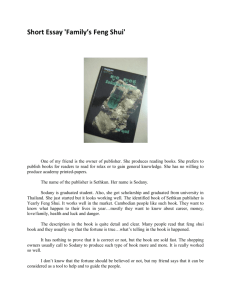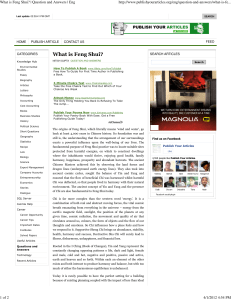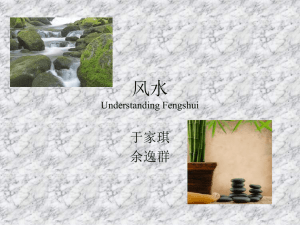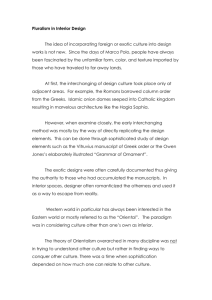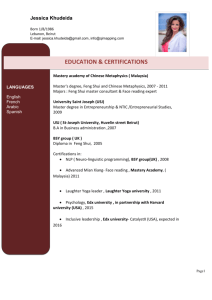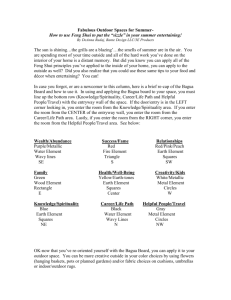Feng Shui - Home Page
advertisement
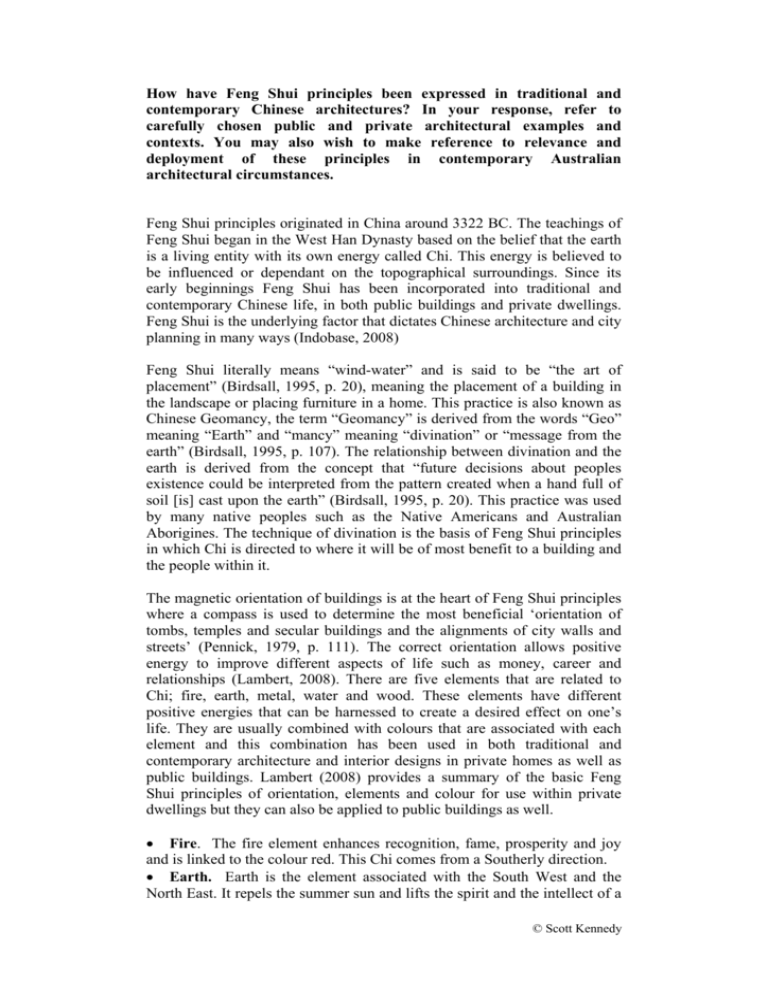
How have Feng Shui principles been expressed in traditional and contemporary Chinese architectures? In your response, refer to carefully chosen public and private architectural examples and contexts. You may also wish to make reference to relevance and deployment of these principles in contemporary Australian architectural circumstances. Feng Shui principles originated in China around 3322 BC. The teachings of Feng Shui began in the West Han Dynasty based on the belief that the earth is a living entity with its own energy called Chi. This energy is believed to be influenced or dependant on the topographical surroundings. Since its early beginnings Feng Shui has been incorporated into traditional and contemporary Chinese life, in both public buildings and private dwellings. Feng Shui is the underlying factor that dictates Chinese architecture and city planning in many ways (Indobase, 2008) Feng Shui literally means “wind-water” and is said to be “the art of placement” (Birdsall, 1995, p. 20), meaning the placement of a building in the landscape or placing furniture in a home. This practice is also known as Chinese Geomancy, the term “Geomancy” is derived from the words “Geo” meaning “Earth” and “mancy” meaning “divination” or “message from the earth” (Birdsall, 1995, p. 107). The relationship between divination and the earth is derived from the concept that “future decisions about peoples existence could be interpreted from the pattern created when a hand full of soil [is] cast upon the earth” (Birdsall, 1995, p. 20). This practice was used by many native peoples such as the Native Americans and Australian Aborigines. The technique of divination is the basis of Feng Shui principles in which Chi is directed to where it will be of most benefit to a building and the people within it. The magnetic orientation of buildings is at the heart of Feng Shui principles where a compass is used to determine the most beneficial ‘orientation of tombs, temples and secular buildings and the alignments of city walls and streets’ (Pennick, 1979, p. 111). The correct orientation allows positive energy to improve different aspects of life such as money, career and relationships (Lambert, 2008). There are five elements that are related to Chi; fire, earth, metal, water and wood. These elements have different positive energies that can be harnessed to create a desired effect on one’s life. They are usually combined with colours that are associated with each element and this combination has been used in both traditional and contemporary architecture and interior designs in private homes as well as public buildings. Lambert (2008) provides a summary of the basic Feng Shui principles of orientation, elements and colour for use within private dwellings but they can also be applied to public buildings as well. • Fire. The fire element enhances recognition, fame, prosperity and joy and is linked to the colour red. This Chi comes from a Southerly direction. • Earth. Earth is the element associated with the South West and the North East. It repels the summer sun and lifts the spirit and the intellect of a © Scott Kennedy room. It is associated with the colours yellow and beige, which are joyous and cheerful. • Metal. The element, metal, is a pure and protective element associated with the colour white. Gold, silver and metallic objects are also believed to provide solid and grounding energies. This element is orientated with the North West. • Water. The water element is symbolised by the colours blue and black and is associated with the North. Blue brings calmness and coolness which helps to relax and calm a room. • Wood. Finally, the wood element relates to the colour green which is a restful and balancing colour as it gives neither a cool nor warm feeling to a room. This element is associated with the East and enhances family and health aspects of life. Wooden floors, ornaments and furniture are used in rooms to harness these qualities. The Feng Shui principles described so far in this essay are ‘based on Taoist philosophy of Yin and Yang, i.e. the two opposites of the universe...male and female, negative and positive...night and day’ (Adhikari, 2006, p. 23). It is believed that the two opposites complement each other in a symbiotic relationship as one cannot exist without the other creating a ‘perfect balance of Yin and Yang’ (Adhikari 2006, p.23). The Yin and Yang symbol of intertwining black and white ‘tadpoles’ (Adhikari 2006, p. 23), depicts the intention of Feng Shui to bring energies into balance in order to positively enhance peoples lives. During ancient times Feng Shui was used to determine the best placement of temples and tombs (Circle-of-light, 2008; Ten Tien Yong, 2008). A conceptual or symbolic model for orientating buildings was used in which a tiger was required to be in the West and a dragon in the East. The tiger and the dragon are symbolised topographically as mountains. The best place for a tomb or temple using this model is inside a horseshoe valley where it is protected from two sides leaving the inhabitants to defend the tomb or temple from only one side (Ten Tien Yong, 2008). in this sense, the main role of a ‘geomancer in Chinese tradition...is to read the forces of nature’ (Braswell-Means, 1990, p. 134). An example of a traditional public building is the Forbidden City in Beijing. With walls 2.25 miles (3.6 km) long and a moat separating it from the rest of Beijing was affirmed as the capital’s heart. The Forbidden City is an example of extremely simple Feng Shui Principles on a grand scale. The Forbidden City is based on a square shape which allows symmetry and balance. The processional path denotes a straight line, orientated North to South through the centre of the city. This central axis signifies the authority of the emperor and the ruling dynasty. The emperor’s palace is the Northern most building which aligns with a strong fire elemental Chi creating recognition, fame and high rank. This axis was also the basis for the central business district which dominated the structure of the city (Britannica, 2008). © Scott Kennedy Traditional principles of Feng Shui have carried over to contemporary times. This transference can be seen in the use of mirrors. Traditional Shoalin geomancers carried a mirror to avert evil spirits and mirrors can be seen in modern times hanging in windows facing the line of approach on which Chi flows. (Braswell-Means, 2006, p. 134). The use of Feng Shui in contemporary architecture is, to some extent quite different to its use in ancient architecture. In contemporary times we are less likely to be threatened by invaders or marauders, therefore we do not necessarily need protecting physically to the same extent. However, Feng Shui is used in contemporary architecture aims to protect the inhabitants of a structure or city from negative influences and to enhance various aspects of life such as health, relationships and finances through the flow of Chi, as desired in ancient times. An example of the contemporary use of Feng Shui principles in a public building is the Hyatt Regency Hotel in Singapore. The Hyatt Regency hired a Feng Shui consultant to make alterations to the hotel. The entrance was altered, a fountain was added in the front courtyard and the information desk was altered. After these changes were made, the Hyatt Regency’s business substantially increased. This was believed to be the result of the adoption of Feng Shui principles. For example, the addition of the fountain was believed to attract money. Altering these features so they are orientated to a South Easterly direction, harnesses the wealth and prosperity Chi, and attempts “to attain visual and cosmic harmony” (Grossman, 1998). Another example of the contemporary use of Feng Shui is in Chinese restaurants. Making a fish tank the first object noticed by visitors, adds the water element to the restaurant which is calming and soothing and is believed attract more wealth. The octagonal shaped family tables resemble the Eight Trigram which is the main decision making tool of Feng Shui. Red silk tassels hanging from ceilings harness the fire element which brings joy and prosperity. Often a mirror will be placed by the cash register which is usually located in the South East corner of the restaurant, thereby utilising the wealth and prosperity Chi. The mirror itself is believed to double profits (Finster-Bytnar, 2008). Feng Shui has retained an important place in Chinese culture and architecture from traditional to contemporary times. This could be because ‘geomancy in China was an integral part of a complex philosophical concept bringing together a number of important principles’ (Braswell-Means, 2006, p. 140). These principles include magnetic orientation, colour, and the use of natural elements (water, wood and so forth). The fact that Feng Shui is based on Taoist philosophy could be one of the reasons for its continued use through time in Chinese culture. Feng Shui is unique in terms of its value to contemporary architectural design at its most basic level. That is ‘in it’s consideration of the proper use of space and natural resources, it can be seen as the world’s only time-proven theoretical approach to the aesthetics of land use’ (Braswell-Means, 2006, p. 140). © Scott Kennedy This essay aimed to demonstrate how Feng Shui principles have been expressed in traditional and contemporary Chinese architecture, through magnetic orientation, the five elemental energies and the colours associated with them. This essay has illustrated how Feng Shui principles have been expressed in the traditional Chinese architecture and in contemporary architecture. The examples of Feng Shui principles outlined in this essay highlight the fact that Feng Shui applications are a valuable architectural resource. With improved technology, urbanisation and a more materialistic and economic orientation, we have become more and more disconnected with the natural world. Feng Shui may be a means to return balance and positive energies to our living and working environments. Reference list Adhikari, I. P., (2006), Feng Shui and library building: An introductory approach, TULSSAA Journal: A Journal of Library and Information Science, 4(5), pp. 23-27. Adhikari contrasts between Feng Shui and Hindu geomancy techniques, which were very helpful in putting Feng Shui into context. Birdsall, G., 1995, The Feng Shui Companion: A User Friendly Guide to the Ancient Art of Placement, Destiny Books, Rochester, Vermont. Birdsall’s information tone helps to define and understand the concept of all Feng Shui principles. Braswell-Means, L., (1990), The Art of Geomancy in the Medieval West and Contemporary Asia, Journal of Popular Culture, 23 (4), 1990. Although Braswell’s article was an article on popular culture, she made some interesting comments on contemporary Asian use of Feng Shui in architecture Circle-of-light.com, 2008, Feng Shui history, viewed 20 May 2008, http://www.circle-of-light.com/fengshui/fs-history.htm This site was quite colloquial and uses a story teller’s tone, which helps us to understand some of the more complex Feng Shui concepts. David Michael Bonavia, 2008, Beijing, viewed 21 May 2008, http://www.britannica.com/EBchecked/topic/448956/Beijing/60542/Citylayout#ref=ref793596 Coming from an extremely reliable source, Bonavia provides a detailed explanation of the Forbidden City and Feng Shui principles. © Scott Kennedy Finster-Bytnar, E. J., (2008), Home and Office Feng Shui, Feng Shui of the Rockies, viewed 28 May 08, http://www.fengshuirockies.com/Home_Office.htm. Finster-Bytnar gave a great example of Feng Shui principles in practise with a look into Chinese restaurant Feng Shui. Grossman, S. (1998), An introduction to Feng Shui, Dezignaré Interior Design Collective, inc., vol. 4.1, 1998, viewed 28 May 08, http://www.dezignare.com/newsletter/fengshui.html Grossman’s views about Feng Shui provided good examples of Feng Shui in different rooms in a private residence. Indobase.com, 2008, History of Feng Shui, viewed 15 May 2008, http://www.indobase.com/fengshui/feng-shui-origin.html This site, allowed a look into Feng Shui from a “closer to home” view rather an outsiders view. Lambert, M., 2008, Feng Shui for Today’s Living, CICO Books, London. Possible the best book on Feng Shui, with its colourful pictures it makes the concept and principles come alive and easy to understand. Pennick, N., (1979), The Ancient Science of Geomancy: Man in Harmony with the Earth, Thames and Hudson, London. This small book was very interesting even though it was predominantly based on Geomancy around the world it showed that Feng Shui is one of the many types of geomancy. Yong, T. T., 1988. Feng Shui: It’s Application in Contemporary Architecture, in MIMAR 27: Architecture in Development, Concept Media Ltd, Singapore. Yong has created a detailed article which he shows us first hand the Feng Shui principles of contemporary Asia. © Scott Kennedy
